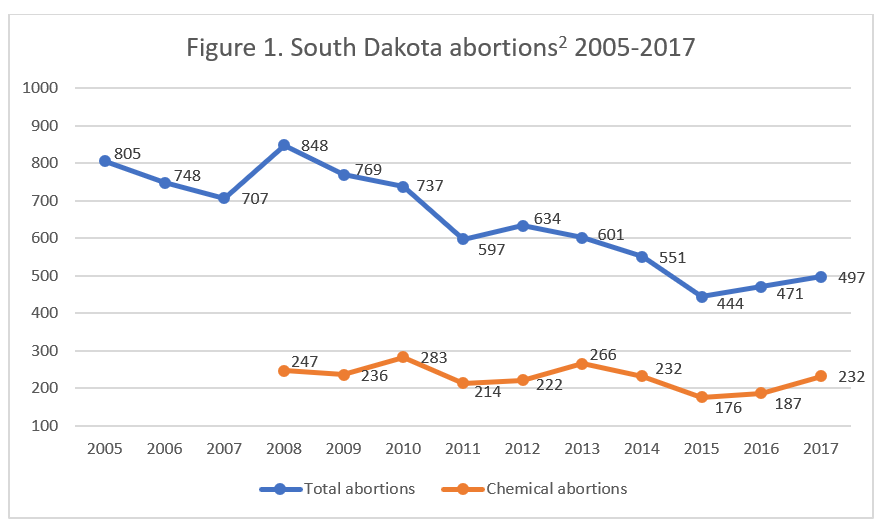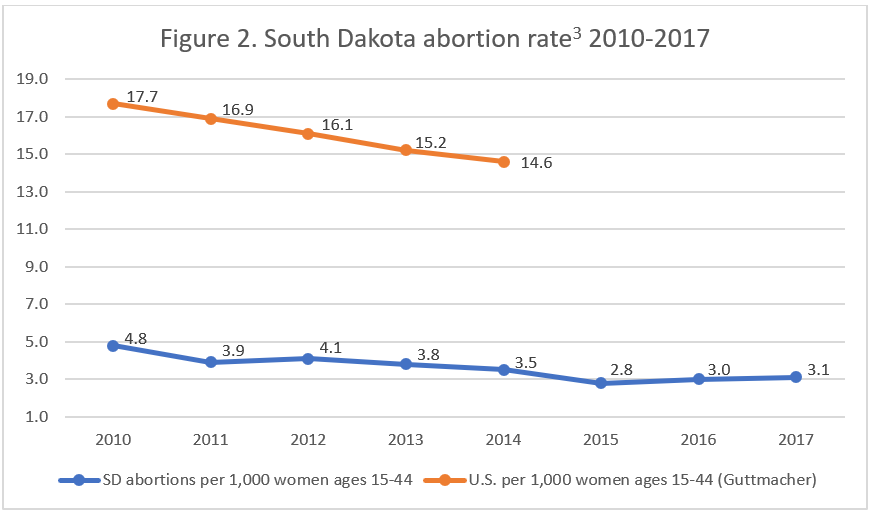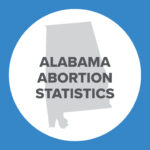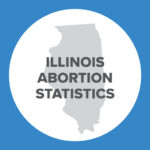Abortion Reporting: South Dakota (2017)
South Dakota’s 2017 abortion report, published on the website of the South Dakota Department of Health in November 2018, shows that abortions in the state increased from the previous year. Some of the increase is likely attributable to a rise in chemical abortions.
Changes in South Dakota Abortions, 2016-2017

*Information on South Dakota’s state abortion rate is not publicly available. CLI has calculated Planned Parenthood’s South Dakota market share using data from the Planned Parenthood of Minnesota, North Dakota, and South Dakota affiliate report.
Abortion Totals and Trends
In 2017, there were 497 abortions reported in South Dakota. This represents a drop of 70 percent from 1974, South Dakota’s first full year of abortion reporting, but an increase of six percent from the previous year. Similarly, chemical abortions in South Dakota have declined by six percent since 2008, the first year they were reported as a separate category, but they have increased by 24 percent from 2016. Chemical abortions made up 47 percent of all abortions reported in South Dakota in 2017. The Charlotte Lozier Institute estimates that South Dakota’s 2017 abortion rate increased slightly from 2016.
State Report Summary
Eighty-five percent of the abortions occurring in South Dakota in 2017 were performed on residents. Over half of the South Dakota residents who underwent abortions lived in Sioux City, the site of South Dakota’s only abortion center. Of the 74 out-of-state women who got abortions in South Dakota, 41 were from Minnesota, 28 were from Iowa, and five were from other unspecified locations. The month of September had the most abortions (52), and April had the fewest (31).
Thirteen percent of the abortions were performed on girls age 19 or younger, including 24 abortions performed on girls under the age of 18. In accordance with South Dakota’s parental consent law, 22 girls received consent from a parent or guardian, while the remaining two obtained judicial waivers exempting them from the requirements. Well over half the abortions performed in South Dakota (56 percent) were on women in their twenties. Twenty-eight percent were performed on women in their thirties and three percent on women age 40 or older.
White women composed the largest racial category, undergoing 72 percent of the abortions reported in the state. Eleven percent of the abortions were performed on black women, 10 percent on American Indian women, five percent on Asian women, and one percent on women of a different race. Black women were overrepresented in the group of women who underwent abortions in South Dakota in 2017: CLI estimates that the black abortion rate was 13.1 abortions per 1,000 black women of childbearing age, while the white abortion rate was only 2.7 abortions per 1,000 women.
More than half the abortions reported in South Dakota were performed on women who had attended some college but had no degree (29 percent) or who had obtained a degree or other certification (27 percent). Another 44 percent had a high school diploma or less. Eighty-two percent were not married, and 18 percent were married. Over half the women had children now living. Twenty-three percent had one child, and 36 percent had two or more, while 41 percent had no living children. The majority of women had never had an abortion before. Seventy-four percent reported no abortions prior to this one, compared to 17 percent with one prior abortion and nine percent with two or more. Eighteen percent had had a prior miscarriage.
Almost a quarter of the abortions were performed at six weeks of gestation or earlier. Thirty-eight percent were performed between seven and eight weeks of gestation, 24 percent between nine and 10 weeks, and 11 percent between 11 and 12 weeks. Three percent of the abortions were performed at 13 weeks of gestation or later. South Dakota prohibits abortions performed after 20 weeks post-fertilization (approximately 22 weeks of gestation) except in cases of risk to the mother’s life or to a major bodily function. Four abortions were known to have caused complications1, and 20 abortions required the use of sharp curettage as a follow-up procedure. Fifty-three percent of the women undergoing abortions were provided with anesthesia.
The vast majority of abortions reported in South Dakota, 89 percent, were self-funded. Eight percent were paid for using private insurance, and three percent (14 abortions) were covered by public health plans. Abortions in South Dakota have become increasingly expensive: in 2017, 11.7 percent of reported abortions cost $700 or more, up from 8.5 percent in 2016 and 4.0 percent in 2005. Almost 78 percent of the doctors performing abortions in South Dakota in 2017 were ob/gyns, and 23 percent specialized in family medicine.
As in previous years, most of the abortions in South Dakota were performed because the mother did not want the baby (65 percent) or could not afford the baby (44 percent). Fourteen percent of the abortions were performed because of the mother’s emotional health. Seventeen abortions (three percent) were performed due to risk to a major bodily function, and eight abortions (1.6 percent) were performed because of rape or incest. Seventy-nine abortions were performed for other, unspecified reasons. Reasons were self-reported, and women could select more than one reason for choosing abortion. In 2017, more than 38 percent of the women indicated multiple reasons. Two of the babies killed by abortions had abnormalities.
Before an abortion is performed on a woman in South Dakota, she must be provided the opportunity to give informed consent. Women are given information on the abortion procedure, assistance available to them, the development of their unborn children, and abortion alternatives. At least 72 hours must elapse before the abortion is performed to ensure that women have enough time to make an informed decision. In 2017, 542 informed consent forms were submitted to the South Dakota Department of Health. Of the 542 forms, 497 indicated that the woman went on to undergo the abortion, while 45 women did not go through with their abortions. In three cases, the required information was not provided due to medical emergencies. As part of the informed consent process, women are provided the opportunity to view their ultrasounds. In 2017, 538 women indicated that they had been offered this opportunity; 235 decided to view their ultrasounds, and 303 chose not to.
Seven percent of the aborted babies weighed less than 50 grams (1.7 ounces). Twelve percent weighed between 50 and 74 grams (1.8-2.6 ounces), and six percent weighed between 75 and 99 grams (2.6-3.5 ounces). Four percent of the babies killed by abortion weighed between 100 and 124 grams (3.5-4.4 ounces). Five percent weighed 125 grams or more (4.4 ounces – more than a quarter of a pound). Typically, unborn babies who weigh 100 grams are 16 weeks old and more than four and a half inches long. Weight was not reported for 65 percent of the babies. Fifty-three percent of the babies killed during abortions were incinerated, three babies were buried, and 46 percent were disposed of via medical waste or an unknown method.
Abortion Facilities in South Dakota
The only licensed abortion facility in South Dakota is operated by Planned Parenthood. According to the South Dakota Department of Health’s abortion facility inspection reports, two hospitals in the state also occasionally provide abortions. South Dakota’s abortion report does not include the number of abortions performed at each facility. However, Planned Parenthood includes its abortion totals in the annual report of the Planned Parenthood of Minnesota, North Dakota, and South Dakota affiliate. During the 2016-2017 fiscal year, which lasted from July 1, 2016 to June 30, 2017, Planned Parenthood reported performing 468 abortions in South Dakota. According to South Dakota’s abortion reports for 2016 and 2017, there were 475 abortions reported in South Dakota between July 2016 and June 2017, producing a Planned Parenthood market share of 98.5 percent.
State Ranking
CLI’s 2016 study of abortion reporting across the country ranked South Dakota’s abortion reports as tied for seventh place in overall quality. South Dakota has a lower abortion volume than almost any other state. According to an estimate from the Guttmacher institute, in 2014, only Wyoming had fewer abortions. South Dakota has strong pro-life protections in place, such as its informed consent process and its regular inspections of abortion facilities. The Mount Rushmore State could improve its reporting by including more information on complications and on the medical emergencies that trigger exceptions to the 20-week law and the informed consent process – information which it already collects. By publishing these statistics in the annual abortion report, South Dakota could allow citizens to see how closely these laws are being followed.


- Statistics on abortion complications reported here represent a minimal number of deaths and complications, as this data is collected in a non-systematic and non-verifiable way. As such, this data cannot be used to calculate either an accurate abortion mortality rate, nor an accurate abortion complication rate for the state.
- South Dakota reports the percentage of chemical abortions, but it does not report actual numbers. Chemical abortion numbers were calculated using the reported percentages.
- South Dakota does not report the state abortion rate. Rates were calculated by the Charlotte Lozier Institute using population estimates from the United States Census Bureau. The rates were calculated using the following formula: (total number of abortions performed in South Dakota ÷ number of resident women ages 15-44) x 1,000.

























